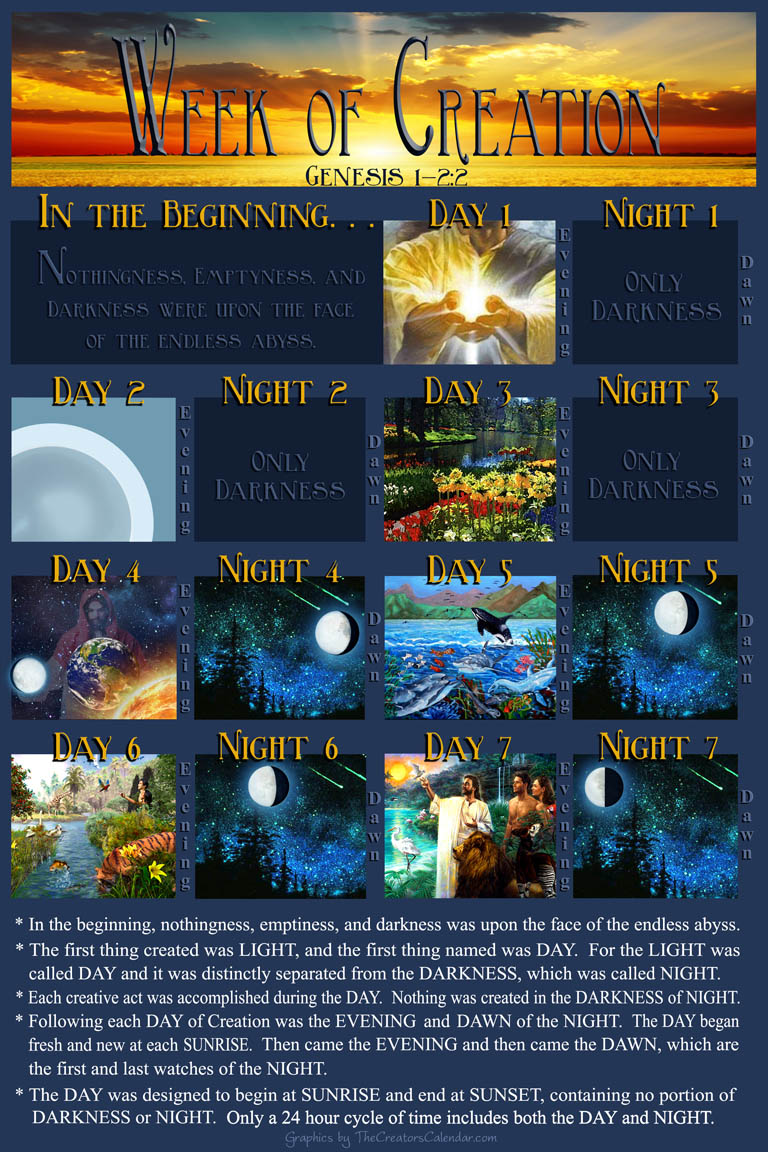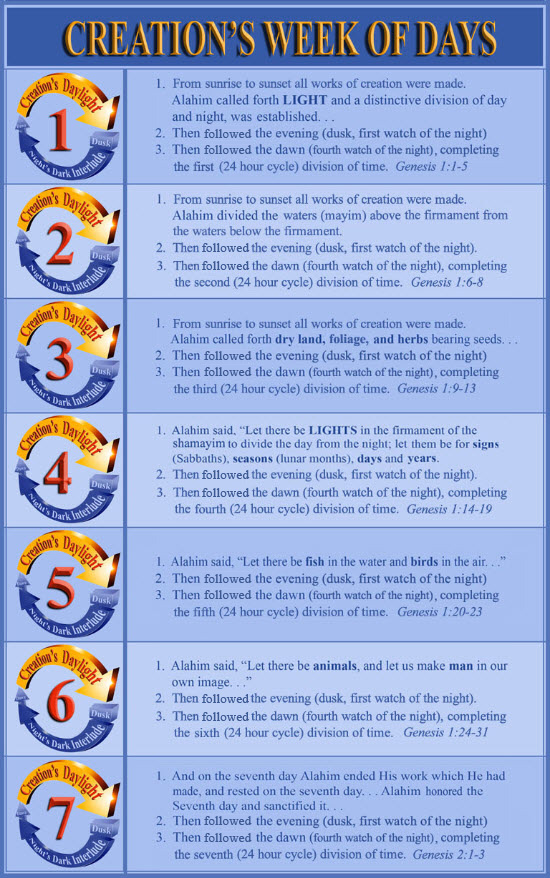Sunrise or Sunset?
SUNRISE or SUNSET
When Does a Day Begin?
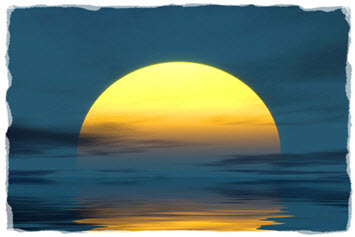
[Disclaimer: In this article, all references to the Roman and Yahudim (Jewish) replacement terms of the Lord, God, Adoni, and Jesus Christ have been returned to their original and true sacred Hebrew names.]
For centuries, the term DAY has been a source of confusion, especially in scriptural translations. This is understandable, as the word has been used interchangeably to describe both a 12-hour period of daylight—from sunrise to sunset—and the full 24-hour cycle, which includes both the day and the four separate night watches.
Despite growing evidence clarifying when the DAY—and more specifically, the Sabbath—was intended to begin, from Creation to the time of the Messiah’s crucifixion and beyond, many religious scholars continue to assume one of two positions. They either adopt the Roman convention of beginning the day at midnight or follow the Rabbinical Pharisaic tradition of starting at sunset. But do either of these align with the weight of Scriptural evidence?
According to the Biblical record, a DAY consists solely of 12 hours—from sunrise to sunset. The night is not measured in hours but rather in four distinct night watches, beginning at sunset and concluding at sunrise. Meanwhile, a civil calendar date spans 24 hours but is NOT synonymous with a DAY. Instead, it comprises both the day (first half) and the night (second half), with the entire cycle commencing at sunrise—not midnight or sunset. This distinction is crucial, as Scripture clearly defines the roles of celestial bodies: the sun governs the DAY (daylight), while the moon and stars rule together by the night (Genesis 1:16).
Now, let us examine the weight of evidence.
Historical Roman Day
Historically, before 46 B.C., the Romans began their day at sunrise, measuring time in 12-hour increments based on the shadow movement of a sundial. The night, in turn, was divided into four watches, precisely as recorded in Scripture (2 Kings 20:8-11; John 11:9; Psalms 63:6; Psalms 119:48; Mark 13:34). However, over the course of 400 years, Roman emperors gradually altered their system of timekeeping—driven by ambitions of power, prestige, and defiance of the Torah laws of Yahuah Alahim (Elohim). These changes ultimately resulted in a calendar that diverged sharply from both the timekeeping of other nations and the Scriptural method of measuring days, months, and years.
The most significant shift began under Julius Caesar in the mid-1st century B.C., when he removed the moon as the primary marker for measuring time. This single decision nike air force 1 uv color change da8301 100 101 release date led to the restructuring of months with arbitrary lengths and the introduction of a fixed eight-day week—severing any connection to the natural lunar cycles of 29 and 30 days. As a result, the Roman calendar evolved into an entirely new system, untethered from the divine order established in Scripture.
“In the mid-1st century B.C. Julius Caesar invited Sosigenes,
an Alexandrian astronomer, to advise him about the reform of the calendar, and Sosigenes decided that the only practical step was to abandon the lunar calendar altogether. Months must be arranged on a seasonal basis, and a tropical [solar] year used, as in the Egyptian calendar, but with its length 365.25 days.” Encyclopedia Britannica, The Julian Calendar, Paragraph 1.
https://www.britannica.com/science/calendar/The-Western-calendar-and-calendar-reforms
“Julius Caesar’s conquest of Egypt in the 1st century B.C. introduced this planetary week to the Roman Empire… Since the astrological [planetary] and Jewish [lunar] weeks were both seven days long, by the 1st century A.D. the day of Saturn [Saturday] had become identified with the Jewish [lunar] Sabbath. After Christianity became the state religion, the Church integrated both cycles to produce our present week, used also by Jews and Muslims.” Sarah Belle Dougherty in her book review of The Seven Day Circle: The History and Meaning of the Week by Eviatar Zerubavel, University of Chicago Press, Chicago and London, 1989. As published in Sunrise magazine, August/September 2003; copyright © 2003 Theosophical University Press.
“…the time of the transition from the reckoning of the day as beginning with morning to the reckoning of it as beginning with evening… that in the earlier calendar and in the literature which records this, the day was reckoned from the morning, presumably from sunrise, while in the later calendar and the literature pertaining thereto the day was reckoned from the evening…Elsewhere we have presented quite a mass of evidence which establishes conclusively that the earlier practice in Israel during the Biblical period was to reckon the [24 hour civil calendar date] day from sunrise to sunrise… That in the earliest period of Israelite sojourn in Palestine, under calendar 1, the day was reckoned from morning to morning is established by a super abundance of evidence… This in turn, together with other important considerations, would point to a time approximately about the beginning or the first half, of the third century B.C. as that of the introduction of the new system of reckoning the day.” Supplementary Studies in the Calendars of Ancient Israel, p. 1-148)
At the Council of Nicaea (321-325 A.D.), Emperor Constantine the Great, driven by deep hostility toward the Yahudim (Jews), ensured that his newly reformed calendar would never align with the Torah’s divinely established timekeeping system. In his official Creed, he explicitly rejected the Creator’s New Moons, lunar seventh-day Sabbaths, and sacred Feast Days. When he transitioned from the eight-day continuous weekly cycle, introduced by Julius Caesar, to a seven-day cycle, it was deliberately structured to never synchronize with the Torah-based calendar recorded by Moses. Instead of following the lunar phases that had long guided the Yahudim, Constantine’s system severed all ties to the celestial rhythms ordained in Scripture.
To this day, the modern planetary seven-day cycle (Sunday through Saturday) remains entirely detached from the moon and its phases, rendering it incompatible as a reflection of the recorded Biblical Creation week or a sign of the Creator’s handiwork.
More than a thousand years later, the Julian Solar Calendar underwent yet another transformation under Pope Gregory XIII. This Gregorian reform adjusted the leap year calculations and shifted the official start of the Roman calendar year from March 25th in the spring to January 1st in the winter. Additionally, 11 days were removed from the month of September in 1752. While these adjustments refined the Roman-mandated continuous weekly cycle, they did nothing to restore its alignment with Scripture’s prophetic astro-luni-solar calendar—one that was divinely designed to track time through lunar years, months, weeks, and days. The disconnect remains, reinforcing how far modern timekeeping has strayed from its original, sacred foundation.
Historical Jewish Day
Parallel to the Roman reforms, the Yahudim (Jews) faced intense pressure during their Roman captivity (beginning in A.D. 70) to abandon the timekeeping system established in the Torah. This transition was ultimately solidified in A.D. 358 under the leadership of Hillel II, head of the Sanhedrin (Rabbinical Pharisee authority). In a pivotal shift, he led the Yahudim to adopt several key changes that would redefine their sacred calendar for generations to come.
At this time, the ancient Babylonian dark conjunction was formally accepted as the marker for the New Moon, replacing the Scriptural New Moon designation. Additionally, the measurement of a 24-hour day was set from sunset to sunset, aligning with Babylonian traditions rather than the Torah’s original sunrise commencement. Perhaps most strikingly, the Yahudim also embraced Rome’s newly established seven-day continuous weekly cycle—a departure from the lunar-based weeks prescribed in Scripture.
This profound realignment with Roman and Babylonian systems forever altered the way time was measured, distancing the Yahudim from the divinely ordained celestial calendar that had once governed their sacred lunar-based worship appointments.
The Document of Convention
To resolve the inherent conflict between the lunar months used for Feast Days and the fixed, uninterrupted cycle of the Roman week—where the seventh day, Saturday, remained constant—the Yahudim (Jews) found it necessary to establish the Rules of Postponement. This set of man-made regulations was designed to artificially harmonize two fundamentally incompatible calendar systems. Like oil and water, these distinct timekeeping methods could never truly blend. Without these adjustments, the Roman seventh day would inevitably cycle unpredictably, sometimes coinciding with the sacred lunar days of the New Moon, Passover (Pasch), or the Day of Atonement (Yom Kippur), creating scheduling dilemmas that the Jewish leaders sought to avoid.
Astonishingly, while many of us have learned about the transition from the Julian to the Gregorian calendar, few—if any—have been taught about the far-reaching consequences of Rome’s stealthy calendar replacement system and its uninterrupted weekly cycle. This shift, which took place in the fourth century A.D., profoundly disrupted our Creator’s ordained calendar. Whether in history or Bible class, our teachers were often unaware of these crucial facts, simply passing down the traditions they themselves inherited. For much of the Western world, particularly in America and Europe, the influence of the Roman calendar has shaped timekeeping for centuries. Yet, the scriptural warning remains:
“Not giving heed to Jewish fables, and commandments of men, that turn from the truth.” — Titus 1:14
For far too long, well-meaning and sincere believers have followed Rabbinical Pharisee and Roman traditions for measuring the beginning of days, weeks, months, and years—traditions that lack scriptural foundation. Yet, the truth has always been available for those willing to seek it. With only a little effort, one can uncover the original Hebrew and Greek texts that expose the falsehoods perpetuated by human tradition.
The very fact that Yahuah Alahim’s divinely appointed timekeeping system is being rediscovered at this late hour should serve as a clear sign that our Messiah’s return is near. He is coming soon for those who walk in obedience to His truth. The following insights into this crucial subject of time are designed to equip His faithful followers for the spiritual battles ahead, preparing them for citizenship in His Eternal Kingdom. While all units of time will be discussed, the primary focus of this article is to expose errors and unveil the Scriptural foundation for determining when the day truly begins.
For more on the historical background of the calendar changes refer to Stunning Historical Evidence.
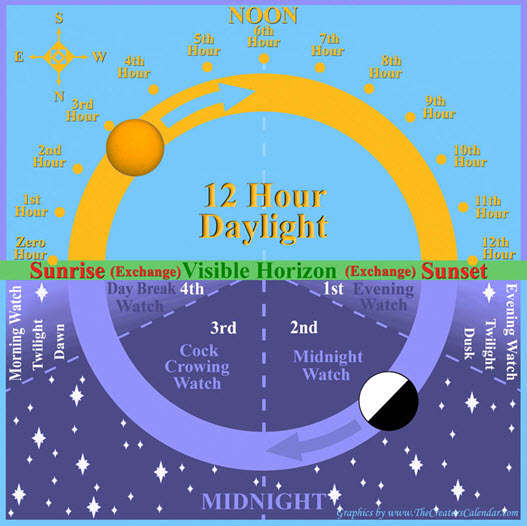
The following 45 questions are designed to get to the root of and expose many false paradigms that have been attributed to Scripture. As a result, the focus is on what Scripture teaches from Genesis to Revelation. In the first portion, Genesis 1:1-5 is utilized often from several angles but will then move forward after establishing several ground rules relating to the parameters of the DAY and the bookends of the NIGHT.
Question 1: According to Genesis 1:1-5, what was the first thing the Creator called forth into existence?
“In the beginning was Alahim/Elohim (#430 אלהים) the Creator, the Aleph and Tav of the shamayim (heavens) and the
Aleph and Tav of the earth. The earth consisted of NOTHINGNESS, EMPTINESS, AND DARKNESS, which were upon the face of the endless abyss. The Ruach (Spirit) of Alahim hovered over the face of the shamayim (deep space). Commandingly declared Alahim, “Let there be LIGHT,” and there was LIGHT. For behold, Alahim, the Aleph and Tav, is the LIGHT and absolute GOODNESS. And separating them, Alahim made a distinction of the LIGHT from the distinction of the darkness. Alahim called the LIGHT “DAY” (as opposed to night), and the darkness He called “night” (as opposed to day). And then followed dusk (the beginning of night), and then followed dawn (the end of night), the first 24 hour division of time.” Genesis 1:1-5 The Creator’s Calendar Restored Text
Question 2: What was the first thing the Creator named?
“And separating them, Alahim made a distinction of the LIGHT from the distinction of the darkness. Alahim called the LIGHT “DAY…”
Question 3: What was the second thing the Creator named?
“and the darkness He called “night” (as opposed to day).”
Question 4: According to Genesis 1:1-5, when did the Creator make the darkness?
Answer: Surprising as this may be to some, the Creator did not make or create the darkness. As defined above, darkness is the absence of LIGHT. Darkness was the absence of the creative force. To make a distinction  between the darkness and the LIGHT, the creator separated them, meaning that they will forever hold different periods of time and never overlap. He then sealed His declaration that He separated them when He gave them their names. DAY and NIGHT are NOT synonymous terms, but opposites.
between the darkness and the LIGHT, the creator separated them, meaning that they will forever hold different periods of time and never overlap. He then sealed His declaration that He separated them when He gave them their names. DAY and NIGHT are NOT synonymous terms, but opposites.
Question 5: Since darkness is the absence of LIGHT, then what is night?
Question 6: According to the entire Renewed Covenant (N.T.), daylight is divided into 12 basic units of time. What are these units called?
“And when those came who were hired about the eleventh hour, they each received a denarius.” Matthew 20:9-10 NKJV
“Yahusha [our Messiah] answered, ‘Are there not twelve hours in the day? If anyone walks in the day, he does not stumble, because he sees the light of this world. But if one walks in the night, he stumbles, because the light is not in him.'” John 11:9-11 NKJV
Question 7: A sundial only works during the hours from sunrise to sunset when the direct rays of the sun are upon it. So what was used to reckon units of time during the dark of night?
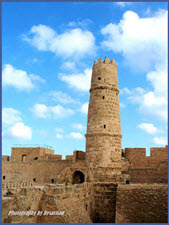
- Evening Watch – This first watch of the night commences at sunset and occupies the period known as dusk or twilight, and ends at the first quarter of the night. This quarter measure of the night is accomplished by measuring the constellation of stars that arises in the east until it reaches the first quarter of the night. Mark 13:35
- Midnight Watch – This second watch is marked off by the ruling constellation as it moves from the first quarter of the night to the middle of the night. This method alone could accurately mark midnight. Luke 12:38
- Cock Crowing Watch – This third watch of the night commences with the ruling constellation of stars at midnight and ends at the third quarter position from east to west across the expanse of the night sky. Also, this was the period that was characteristic of when the rooster began to crow. Luke 12:38
- Morning Watch – This fourth watch of the night commences at the first visible light in the eastern sky, the time the rooster begins to crow, which is also known as dawn or morning twilight, the mixture of light and darkness. The Morning Watch ends at sunrise. (Or it may have been simply the last quarter of the time the ruling constellation made its way from the eastern horizon to the western prior to sunrise.) Matthew 14:25
The term night watch was born out of the idea of watching for the first rays of a new DAYLIGHT at sunrise. The focus was always on the LIGHT, looking for the LIGHT, ever seeking the LIGHT. In this way, a living illustration was created that expressed the value Yahuah places on the LIGHT OF DAY (DAYLIGHT) in contrast to the darkness of night.
“For every one that does evil hates the LIGHT, neither comes to the LIGHT, lest his deeds should be reproved. But he that does truth comes to the LIGHT that his deeds may be made manifest, that they are wrought in Alahim.” John 3:20-21
“But if your eye be evil, your whole body shall be full of darkness. If therefore the LIGHT that is in you is darkness, how great is that darkness! No man can serve two masters: for either he will hate the one, and love the other; or else he will hold to the one, and despise the other. You cannot serve Alahim and mammon.” Matthew 6:23-24
“You are all the children of LIGHT, and the children of the DAY: we are not of the night, nor of darkness. Therefore let us not sleep, as do others; but let us watch and be sober.” 1 Thessalonians 5:5-6
“Again, a new commandment I write to you, which thing is true in Him and in you, because the darkness is passing away, and the true LIGHT is already shining. He who says he is in the LIGHT, and hates his brother, is in darkness until now. He who loves his brother abides in the LIGHT, and there is no cause for stumbling in him. But he who hates his brother is in darkness and walks in darkness, and does not know where he is going, because the darkness has blinded his eyes.” 1 John 2:8-11 NKJV
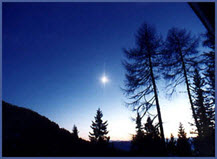 noon? Yet, there are some factions of people around the world that recognize these periods as the beginning of their “day” and specifically on behalf of their sacred day.
noon? Yet, there are some factions of people around the world that recognize these periods as the beginning of their “day” and specifically on behalf of their sacred day.“Thus says Yahuah, who gives the sun for a light by day, the ordinances of the moon and the stars for a light by night. ‘If those ordinances depart from before Me, says Yahuah, then the seed of Israel shall also cease from being a nation before Me forever.'” Jeremiah 31:35-36 NKJV
From this verse, we can acquire Cheap Poligo Jordan Outlet , Women's Off - air jordan 1 mid gs black red white - White™ x Air Jordan 4 "Sail" Release the following facts:
- When the above verse speaks of the stars it is speaking of visible stars.
- When it speaks of the sun the same principle applies, therefore it speaks of a visible sun.
- When stars are present and visible, it is night.
- When the sun is present and visible, it is day.
- The sun and stars are NEVER visible at the same time.
- A visible moon is also spoken of as a light by night on the night it rules. One night only each month, the full moon is visible and rules the entire night from east to west in both hemispheres. This unique night we have come to understand identified the authentic and original New Moon, when it is a full LIGHT by night. Throughout the entire month, the moon in its similitudes, spends exactly the same visible time in the day sky as it does in the night sky. But it rules one night only marking the ruling constellation for that lunar month.
- This is the direct instruction by the Creator, Yahuah, for the division of day and night.
- Each of these lights (the sun, moon, and stars) only rule when they are visible, journeying the entire length of the sky from east to west, and never from west to east when not visible.
Day and night are here differentiated specifically by the sun and the stars. They simply are never visible at the same time. When the sun ceases to shine, the stars begin shining. Please notice that it is not merely light that is given for the portion that makes up the DAYLIGHT, but rather it is the visible presence of the sun that is for a light by day.
The Mazzeroth (wheel of the stars) perpetually shines forth from the shamayim (heavens) by night as they revolve from east to west from one ruling constellation to the next. The word “ordinance” here means the appointed and numbered time circuit of the sun, moon, and stars. It is the moon and stars that were ordained to rule by night. At sunset, one or two planets/stars begin to be visible, and one or two stars continue to be visible until sunrise.
How much more clear could our loving Father be? If the DAYLIGHT occupied the period from dawn (pre-sunrise) through the end of dusk (post-sunset), the “day” would also be overlapping the ruling stars and moon for 1 ½ to 2 hours at dusk and then again just before sunrise. We can know with certainty as a second witness to sunrise and sunset that the period just before sunrise is still considered “night” by the Creator, as well as just after sunset because there is at least one planet/star visible just prior to sunrise and at least one planet/star visible just after sunset.
It was the Creator Himself who clarified that the division between DAY and NIGHT is made manifest by the visible sun, moon, and stars. When the DAYLIGHT is divided properly, there will NEVER be overlapping of His celestial LIGHTS. Therefore, the only possible parameters of the day are from sunrise to sunset, as there is no overlapping of sunshine with the ruling moon and stars by night. The moment the radiant beams of the sun disappear at sunset, the first stars begin to appear in perfect harmony with the division of day and night in Genesis 1 and Exodus 16 account.
“For what fellowship has righteousness with lawlessness? And what communion has LIGHT with darkness?” 2 Corinthians 6:14
Refer to the article, Visible Stars Define the Parameters of Day and Night.
Question 10: According to Genesis 1:5, when does night begin and end?
“Alahim called the LIGHT DAY [as opposed to night], and the darkness He called NIGHT [as opposed to day].” Genesis 1:5
Question 11: So if a night begins at sunset, occupying the entire dark period, when does a DAY (daylight) begin?
“Alahim called the LIGHT DAY [as opposed to night], and the darkness He called NIGHT [as opposed to day].” Genesis 1:5
Question 12: According to the modern Scripture translations of Genesis 1:5, what is the definition given for the word “evening?”
“Alahim called the LIGHT DAY [as opposed to night], and the darkness He called night [as opposed to day].” Genesis 1:5
#1689 Theological Wordbook of the Old Testament (TWOT) corresponds to #6153 in Strong’s Concordance.
‘ereb: Evening, night. Likely developed from the expression, “the setting of the sun, sunset.” Includes: to enter, to go down of the sun. . .
‘ereb is found 131 times in the OT. The phrase “there was an evening and there was a morning” occurs six times in the creation narrative (Genesis 1:5-31), delimiting the six days of divine creative activity. This phrase would indicate that in ancient Israel a day began with sunrise. Some have felt this at variance with the Jewish practice of regarding sunset as the beginning of the next day. Cassuto, after dealing with the Biblical data and the Jewish custom, concludes that there was “only one system of computing time: the day is considered to begin in the morning . . . This judgment appears vindicated in the employment of “ereb in Levitical legislation respecting uncleanness. One was considered unclean because of certain acts “until the evening” (Lev. 11:24, plus thirty times). This is that, one was unclean for the duration of the day. Theological Wordbook of the Old Testament (TWOT) #1689, p. 694.
Evening literally means sunset, night, and dusk.
Question 13: According to Genesis 1:5, does the Creator say that the evening is part of the day or part of the night?
Here is how the text should be read. Note the first sentence identifies the creation event followed by what occurred after that day’s creation event:
“Alahim called the LIGHT DAY, and the darkness He called night. And then followed dusk, and then followed dawn, the first 24 hour division of time.” Genesis 1:1-5 The Creator’s Calendar Restored Text
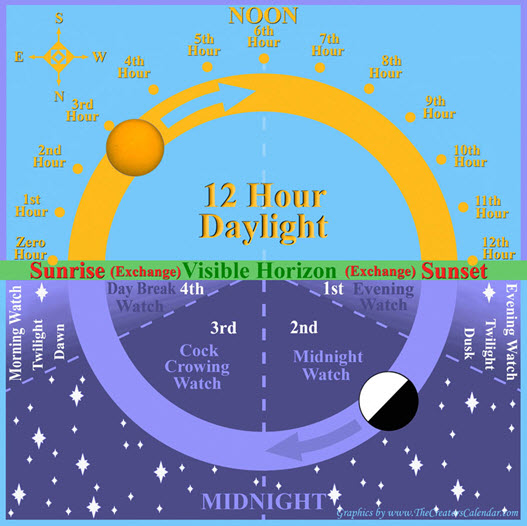
Question 15: Now, with a more complete understanding of the differences between day and night as declared by the Creator, during what period of time did He do all of His works of creation?
“And the earth brought forth grass, the herb that yields seed according to its kind, and the tree that yields fruit, whose seed is in itself according to its kind. And Alahim saw that it was good. Then occurred the dusk (twilight), then occurred the dawn (twilight), day three.” Genesis 1:12-13
Below is an illustration delineating creation’s daily cycle of time as it is outlined in Scripture. All creation occurred during the daylight (in gold) from sunrise to sunset. This is then followed by the evening twilight exchange that ushers in the darkness of the night.
For questions regarding the first four days of Creation, refer to the article, The Fourth Day of Creation, the Introduction of the Sun, Moon, and Stars.
Question 16: In Genesis 1, Moses records the Creator declaring six times the above circle of time, day one, two, three, etc. So when the seventh day is mentioned in Chapter 2, what period of time did the Creator designate as sacred with three witnesses? Was it a full circle of time, such as the night followed by the day, the daylight followed by the night, or was it only to be the daylight hours?
“And on the seventh daylight Alahim ended His work which He had made, and He rested on the seventh daylight from all His work which He had made. 3 Then Alahim honored the seventh daylight and sanctified it, because in it He rested from all His work which Alahim had created and made.” Genesis 2:2-3 NKJV
Answer: The sacred hours of the Sabbath are only the DAYLIGHT portion of the full 24-hour circle of time and are reckoned by hours. Nowhere in Scripture is there a hint of the night watches occurring on the Sabbath. If the day was to begin at sunset, this Scripture verse would be the place where it would be overtly declared by the Creator, stating He rested on the seventh night at sunset, three times instead of the seventh daylight. See John 11:9. The foundational truth established in Genesis 1:5 was the permanent division that separated the daylight from the night. All creation was performed during the daylight, so it stands to reason that when the Creator ceased or rested on the seventh daylight, it was during the same time period that He formerly performed all His work of creating.
Question 17: What examples from Scripture show that our Creator designed the physical realities of LIGHT and darkness with a spiritual symbolic application?
-
But the path of the just is as the shining light that shines more and more unto the perfect day. The way of the wicked is as darkness: they know not at what they stumble. Proverbs 4:18-19
-
Yahusha, the Messiah, said, “I am the light of the
 world: he that follows me shall not walk in darkness but shall have the light of life.” John 8:12
world: he that follows me shall not walk in darkness but shall have the light of life.” John 8:12
-
“Ye are the light of the world.” Matthew 5:14
-
“Let your light so shine before men” Matthew 5:16
-
In Him was life, and the life was the light of men. And the light shines in the darkness, and the darkness comprehended it not. John 1:4
-
The same came for a witness, to bear witness of the light that all men through him might believe. John 1:7
-
“For everyone that does evil hates the light, neither comes to the light, lest his deeds should be reproved. But he that does, comes to the light, that his deeds may be made manifest, that they are wrought in Alahim.” John 3:20
-
But ye are a chosen generation, a royal priesthood, a set-apart nation, a peculiar people; that ye should show forth the praises of him who had called you out of darkness into His marvelous light. 1 Peter 2:9
-
But all things that are reproved are made manifest by the light: for whatsoever does make manifest is light. Ephesians 5:13
“Then Alahim said, “Let there be LIGHTS in the firmament of the shamayim to divide the day from the night; and let them be for signs and seasons [appointed times of assembly], and for days and years.” Genesis 1:14 NKJV
“Every good gift and every perfect gift is from above, and comes down from the FATHER OF LIGHTS, with whom there is no variation or shadow of turning.” [full sun, full stars, full moon] James 1:17 NKJV
Answer: LIGHTS! Notice it does not say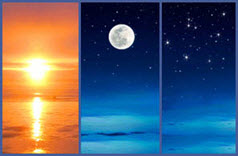 nights and darkness, but LIGHTS were given to divide the day from the night. The DAY is governed by the direct rays of the sun, marking time on a sundial from sunrise to sunset. The night lights appear at sunset, and one by one, the stars begin to shine. Also, our Creator is referred to as the FATHER OF LIGHTS, in which there is no shadow of a turning orbit. Note that the sun and stars never have a shadow covering them, so this reference to “no shadow” is specifically regarding the moon. When the moon represents the “Father of Lights,” it is only when there is no shadow of its turning orbit. There is only one lunar phase that fits this description, and that is the full moon. This is only one of many reasons the full moon has been discovered to be the Creator’s original New Moon. All Praise Yahuah!
nights and darkness, but LIGHTS were given to divide the day from the night. The DAY is governed by the direct rays of the sun, marking time on a sundial from sunrise to sunset. The night lights appear at sunset, and one by one, the stars begin to shine. Also, our Creator is referred to as the FATHER OF LIGHTS, in which there is no shadow of a turning orbit. Note that the sun and stars never have a shadow covering them, so this reference to “no shadow” is specifically regarding the moon. When the moon represents the “Father of Lights,” it is only when there is no shadow of its turning orbit. There is only one lunar phase that fits this description, and that is the full moon. This is only one of many reasons the full moon has been discovered to be the Creator’s original New Moon. All Praise Yahuah!
Question 19: If a DAY begins at sunset when it becomes dark, then when does a “night” begin?
“When the Gazites were told, ‘Samson has come here!” they surrounded the place and lay in wait for him all night at the gate of the city. They were quiet all night, saying, “In the morning, when it is daylight, we will kill him.'” Judges 16:2 NKJV
“You make darkness, and it is night, in which all the beasts of the forest creep about.” Psalms 104:20 NKJV
“While the earth remains,
seed-time and harvest,
cold and heat,
summer and winter,
and day and night
shall not cease.”
Genesis 8:22 KJV
Answer: Day and night DO NOT both start simultaneously at the same moment. If so, they would be the same thing. A day starts when it becomes daylight (direct rays of sunlight), according to Judges 16:2. The night starts when it becomes dark, the time when the animals begin to creep about, according to Psalm 104:20.
The most striking of the examples above is the third one from Genesis 8:22, which illustrates this point with four unique comparisons. Each of these comparisons is the total opposite found in nature, illustrating day and night as the ultimate epitome of opposites.
If this were not enough, notice that each of the examples for comparison is given in their precise order: Seed time must precede the harvest in all cases. Cold existed prior to the creation of the sun. Because the Scriptural year commences in spring, the summer will occur first as the year ends with winter. Likewise, the day commences prior to the night in perfect harmony with the previous three examples. Each of these comparisons is punctuated ir jordan 3 whataburger custom with the promise given to Noah when coming out of the ark that these shall perpetually remain on earth and “shall not cease.”
From the Book of Jubilees comes an interesting parallel, nearly word for word, of Yahuah’s promise to Noah in Genesis 8:22. It appears to have escaped the scrutiny of Constantine or the later Correctories of Rome, as it declares a vital truth in five revealing words at the very end. (Disclaimer: We do not endorse the Book of Jubilees as a whole, for it contains many contradictions.)
“. . . All the days of the earth,
seed-time and harvest
shall never cease,
cold and heat,
summer and winter,
and DAY AND NIGHT
SHALL NOT CHANGE THEIR ORDER
NOR CEASE FOREVER.”
Book of Jubilees 6:4-5
Subsequently, according to this historical manuscript, not only shall these “not cease forever,” but their ORDER SHALL NOT CHANGE. But has the order of the day and night changed? According to Rome, the night comes first as their day begins at midnight. According to the modern Rabbinical Pharisee Yahudim (Jews), the night comes first as the day commences at sunset.
One must ask— was this vital principle of the DAY, which is so clearly stated in the Book of Jubilees and in Genesis 22:8, proactively removed from the Scriptures so mankind today would blindly believe all that Rome and the modern Rabbinical Jews declare? I believe yes!
Question 20: Is “midnight” the middle of the night or the middle of the day?
“And so it was, at noon, that Elijah mocked them and said, ‘Cry aloud, for he is a Alahim (god); either he is meditating, or he is busy, or he is on a journey, or perhaps he is sleeping and must be awakened.'” 1 Kings 18:27 NKJV
Question 21: When the Scriptures speak about the break of day in 2 Samuel 2:32, Judges 19:25, and Job 7:4, is this speaking of sunrise or sunset?
“Then they took up Asahel and buried him in his father’s tomb, which was in Bethlehem. And Joab and his men went all night, and they came to Hebron at daybreak.” 2 Samuel 2:32 NKJV
“But the men would not heed him. So the man took his concubine and brought her out to them. And they knew her and abused her all night until morning; and when the DAY began to break, they let her go.” Judges 19:25 NKJV
“Then Alahim said, ‘Let there be lights in the firmament of the shamayim to divide the day from the night; and let them be for signs and seasons, and for days and years; and let them be for lights in the firmament of the heavens to give light on the earth;’ and it was so. Then Alahim made two great lights: the greater LIGHT to rule the DAY, and the lesser LIGHT to rule the NIGHT with the stars
He made the stars also. Alahim set them in the firmament of the shamayim to give light on the earth, and to rule over the day and over the night, and to divide the light from the darkness. And Alahim saw that it was good.” Genesis 1:14-18 NKJV
“To Him who made great lights, for His compassion endures forever, The sun to rule by day, for His compassion endures forever; the moon and stars to rule by night, for His compassion endures forever.” Psalms 136:7-9 NKJV
“I know that whatever Alahim does, it shall be forever. Nothing can be added to it, and nothing taken from it. Alahim does it, that men should fear before Him.” Ecclesiastes 3:14 NKJV
“The grass withers, the flower fades, but the word of our Alahim stands forever.” Isaiah 40:8 NKJV
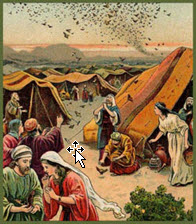 Question 25: In Numbers 11:32, it says that the Children of Israel gathered the quail all that day, and all that night, and all the next day. So, how many days and how many nights did they gather quail?
Question 25: In Numbers 11:32, it says that the Children of Israel gathered the quail all that day, and all that night, and all the next day. So, how many days and how many nights did they gather quail?
“And the people stayed up all that day, all night, and all the next day, and gathered the quail (he who gathered least gathered ten homers); and they spread them out for themselves all around the camp.” Numbers 11:32 NKJV
Answer: They gathered quail for two daylights and one night. But if a DAY begins at night, then they would have gathered quail three days and three nights. But the most profound evidence in the verse above is the inference that the night followed the day. So, the night that belonged to the first day mentioned was the night that followed it. Then the reference was made that the second day mentioned was the “next day.” From this verse, the day begins at sunrise and NOT at sunset.
Question 26: If the day begins at sunrise, then why do the Scripture verses that describe when the Messiah was resurrected say “early in the morning” while it was yet dark?
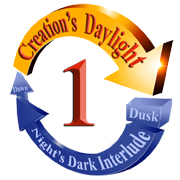 Answer: Great question. An error has been discovered in the Greek translations that place the word “early” or “early in the morning” in place of the Greek word “proi” #4404. While it has been regularly translated to mean “early in the morning,” it actually means during the “fourth watch of the night,” “daybreak watch,” or “dawn.” See Mark 16:2, 9; John 20:1; Matthew 20:1
Answer: Great question. An error has been discovered in the Greek translations that place the word “early” or “early in the morning” in place of the Greek word “proi” #4404. While it has been regularly translated to mean “early in the morning,” it actually means during the “fourth watch of the night,” “daybreak watch,” or “dawn.” See Mark 16:2, 9; John 20:1; Matthew 20:1
Strong’s Concordance Greek Definition:
#4404 (proi) = at dawn; by implication, the Daybreak Watch. 1. Proi is the fourth watch of the night.
Please do not miss this point. Dawn air jordan 6 toro and dusk are both equated with the night and not with the day. It is in these very Scripture verses intended to prove that dawn is part of the day that the weight of evidence is given to the contrary. Yet, dawn is synonymous with the last watch of the night. These verses include all the time references in the Brit Hadasha (NT) to the Resurrection. For a full breakdown with illustrations, refer to the article: Three Days and Three Nights, the Sign of Yonah Riddle Solved.
Question 27: If Yahuah gave the manna from above only for the purpose of feeding the people and illustrating which day was the seventh-day Sabbath, then why is there so much written in Exodus 16 about other time units def
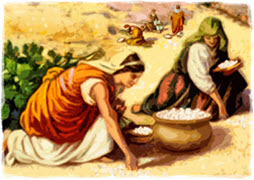 ined by the daily manna?
ined by the daily manna?
He gave precise specifications regarding the gathering of the manna as He stated it would be used to test their obedience to Him. It was His ordained plan to use a feeding schedule to restore Yashar’al (Israel) back to His original Astro-luni-solar time-measuring model for harmonious corporate worship.
- . . .that I may prove them, whether they will walk in my law, or no. Exodus 16:4
- . . . the people shall go out and gather a certain rate every day [daylight] . . . Exodus 16:4
- . . . on the sixth day they shall prepare that which they bring in; and it shall be twice as much as they gather daily. Exodus16:5
- . . . in the morning, then you shall see the majesty of Yahuah . . . Exodus 16:7
- . . . in the morning you shall be filled with bread; and you shall know that I am Yahuah your Alahim. Exodus 16:12
- And when the dew that lay was gone up, behold, upon the face of the wilderness there lay a small round thing, as small as the hoar frost on the ground. Exodus 16:14
- Referring to what had been gathered that day, they were instructed: “Let no man leave of it till the [next] morning.” Exodus16:19
- . . . some of them left of it until the [next] morning, and it bred worms, and stank. . . Exodus 16:20
- . . . when the sun waxed hot, it melted. Exodus 16:21
- . . . on the sixth day they gathered twice as much . . . Exodus 16:22
- Moses said, this is what Yahuah said, Tomorrow [next daylight] is the rest of the sacred Sabbath unto Yahuah: bake that which you will bake today, and seethe that you will seethe; and that which remains over lay up for you to be kept until the [tomorrow] morning. Exodus 16:23
- And they laid it up till the morning, as Moses bade: and it did not stink, neither was there any worm therein. Exodus 16:24
- And Moses said, eat that today; for today is a Sabbath [which began at morning] unto Yahuah: today you shall not find it in the field. Exodus 16:25
- Six days [daylights] you shall gather it; but on the seventh day [daylight], which is the Sabbath, in it there shall be none. Exodus 16:26
- See, for that Yahuah hath given you the Sabbath, therefore he gives you on the sixth day [daylight] the bread of two days [daylights]; abide you every man in his place, let no man go out of his place on the seventh day [daylight]. Exodus 16:29
- So the people rested on the seventh day [daylight]. Exodus 16:30
Here it is found that the Sabbath of the Eternal Father is the seventh daylight and that it follows six work daylights. In these verses, the day begins in the morning at sunrise rather than at night, as has been declared by Jewish fables and commandments of men (Titus 1:14). The manna could be preserved for exactly 24 hours from the time it was given and always went bad the next morning when the fresh, new manna was provided at sunrise, except for the Sabbath. On this day, it was safely preserved for a minimum of 36 hours and a maximum of 48.
We find that the term tomorrow is referred to as the next daylight that commences at sunrise. On the sixth day, Moses spoke of tomorrow as being the Sabbath day or daylight that commenced in the morning. If the Sabbath had begun at sunset, Moses would have spoken regarding the Sabbath tonight or at sunset. The Sabbath began in the morning, as depicted by no manna given that morning. In this entire Exodus 16 narrative, there is not one mention of the words night, sunset, dusk, or evening. The weight of evidence declares in this story alone that the day commences at sunrise in the morning.
Question 28: According to Exodus 18:13, when does “the next day” begin, in the evening, at midnight, or in the morning?
“And so it was, on the next day, that Moses sat to judge the people; and the people stood before Moses from morning until evening.” Exodus 18:13 NKJV
“And it came to pass on the morrow, that the firstborn said unto the younger, Behold, I lay yesternight with my father: let us make him drink wine this night also; and go thou in, and lie with him, that we may preserve seed of our father.” Genesis 19:34
Question 30: From the time of Moses through to the death of the Messiah on the cross, a period of fifteen hundred years, both the morning and evening
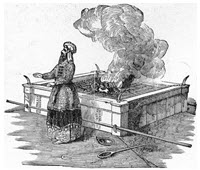 sacrifices were a regular 24-hour occurrence. Did this actually start with the evening sacrifice, then followed by the morning sacrifice?
sacrifices were a regular 24-hour occurrence. Did this actually start with the evening sacrifice, then followed by the morning sacrifice?Question 31: If the day commenced at sunset, then why would the Most High charge the Kohen priests to open the daily temple regimen each morning?
“And on all sides of the temple of Alahim they lodged, because the Most High charged them on behalf of its opening, to be morning by morning.” 1 Chronicles 9:27 (Please click here to see the supporting Hebrew word study.)
And so it was, on the sixth day, that they gathered twice as much bread, two omers for each one. And all the rulers of the congregation came and told Moses. Then he said to them, ‘This is what Yahuah has said: ‘Tomorrow is a Sabbath rest, a sanctified Sabbath to Yahuah. Bake what you will bake today, and boil what you will boil; and lay up for yourselves all that remains, to be kept until morning.’ “So they laid it up till morning, as Moses commanded; and it did not stink, nor were there any worms in it. Then Moses said, “Eat that today, for today is a Sabbath to Yahuah; today you will not find it in the field. Exodus 16:22-25 NKJV
Question 33 If a night is considered a day, then what did Yahuah mean when He said that He would cause it to rain on the earth for forty days and forty nights?
“For after seven more days I will cause it to rain on the earth forty days and forty nights, and I will destroy from the face of the earth all living things that I have made.” Genesis 7:4 NKJV
Answer: Night is not considered the day or even the beginning of a day, but rather, days and nights are exact opposites. For what fellowship has righteousness with lawlessness? And what communion has LIGHT with darkness? 2 Corinthians 6:14 Although this verse is speaking of not being unequally yoked together with unbelievers, it also aptly applies to the day and night not being unequally yoked.
Notice in the words of Yahuah Himself that He identifies that the forty DAYS are followed by forty NIGHTS. The Father always makes precise declarations, and He did not say it would rain forty nights and forty days.
Question 34: Why is it that the righteous men, obedient followers, are stirred up against the hypocrites? Who are the hypocrites, and what did they do to deserve to be called hypocrites?
“Upright men are astonished at this, and the innocent stirs himself up against the hypocrite. Yet the righteous will hold to his way, and he who has clean hands will be stronger and stronger. “But please, come back again, all of you, for I shall not find one wise man among you. My days are past, My purposes are broken off, even the thoughts of my heart. They change the night into day; ‘The light is near,’ they say, in the face of darkness.” Job 17:8-14 NKJV
Answer: The righteous men are stirred up against the hypocrites because the hypocrites make the Creator out to be a liar when He said He separated the day from the night (Genesis 1:4). For the hypocrites have changed the night into day when our Creator had declared the LIGHT to be day and not the darkness of night. The hypocrites here are referred to as any group, organization, nation, power, or religious system that knows the truth yet causes the people to perceive that the DAY begins at night. This would include ancient Babylon, Egypt, unfaithful Yashar’al (Israel), the Romans, and any modern factions. But most profoundly, Yashar’al (Israel) can be called hypocrites, for they had been given the direct honor of bearing the oracles of truth, yet they followed after their heathen neighbors. But since the first century A.D., under pressure from the Romans, the Yahudim (Jews) proactively changed every unit of time by 180 degrees, including when the day began. So is it possible that the modern Rabbinical Pharisee Yahudim (Jews) commence their Sabbath day according to our Creator’s preordained criteria?
Refer to the article, The Creator’s Calendar Units of Time.
Question 35: If it had always been true that the day commenced with the night, then the following words of our Creator would never have been necessary.
“And the word of Yahuah came to Jeremiah, saying, “Thus says Yahuah: ‘If you can break My covenant with the day and My covenant with the night, so that there will not be day and night in their [separate and distinct] seasons, then My covenant may also be broken with David My servant, so that he shall not have a son to reign on his throne, and with the Levites, the priests, My ministers.” Jeremiah 33:19-21 NKJV
Question 36: According to the words of the Most High, what is the difference between a day and a night?
“Thus says Yahuah, who gives the SUN FOR A LIGHT BY DAY, the ordinances of THE MOON AND THE STARS FOR A LIGHT BY NIGHT, who disturbs the sea, and its waves roar (Yahuah of hosts is His name): ‘If those ordinances depart from before Me, says Yahuah, then the seed of Israel shall also cease from being a nation before Me forever.'” Jeremiah 31:35-36 NKJV
“To Him who made great lights, for His mercy endures forever– The sun to rule by day, for His mercy endures forever; the moon and stars to rule by night, for His mercy endures forever. Psalms 136:7-9 NKJV
Answer: Day is ruled by the presence of the sun, and night is ruled only by the moon and stars without the presence of the sun. Jeremiah 31:35 and Psalm 136:7-9. Genesis 1:5 states: “Alahim called the LIGHT day and the darkness he called Night.”
By extension, the sun CANNOT be present on the night that the New Moon rules and marks the next starry constellation to rule with it for the lunar month. The Creator’s rules require that the sun NEVER rules together with the moon or stars. In actuality, the sun is completely absent while the New Moon rules with the stars along the east-west time continuum on the night of the true “full” New Moon.
Genesis 1:16 and Psalms 136:7-9 stand as HALLMARKS against the modern Zodiac, or wheel of the stars, utilized by both the Romans and Jews, in which the ruling month is either defined by the sun or a dark occulted moon or crescent during the daylight.
Question 37: In Jeremiah 33:19-21, Yahuah speaks about the penalty that He would bring upon the house of David and the kingdom of Israel if they broke His covenants. What was the covenant that He was stressing that His people not break?
“Thus says Yahuah, who gives the sun for a LIGHT by day, the ordinances of the moon and the stars for a LIGHT by night, who disturbs the sea, and its waves roar Yahuah of hosts is His name): ‘If those ordinances depart from before Me, says Yahuah, then the seed of Israel shall also cease from being a nation before Me forever.'” Jeremiah 31:35-36 NKJV
This verse has a greater application than first appears on the surface. First, it confirms Yahuah’s promise that He will never change His unique and divinely appointed Astro-Luni-Solar time system. It states that if the ordinances that separate the “sun” for days and “moon and stars” for nights depart, so will the “seed of Yashar’al (Israel)” cease from being a nation forever.” This is guaranteed!
Question 38: What does Yahuah declare will happen if the ordinance of day and the ordinance of the night are changed or removed?
“Thus says Yahuah, who gives the sun for a light by day, the ordinances [laws] of the moon and the stars for a light by night, who disturbs the sea, and its waves roar Yahuah of hosts is His name): ‘If those ordinances [laws] depart from before Me, says Yahuah, then the seed of Israel shall also cease from being a nation before Me forever.'” Jeremiah 31:35-36 NKJV
“And he shall speak great words against the most High, and shall wear out the saints of the most High, and think to change times and laws: and they shall be given into his hand until a time and times and the dividing of time.” Daniel 7:25
Question 39: Isn’t Leviticus 23:32 yet another support for when the “day” begins, commencing at sunset and terminating the following sunset, as it states, “from even unto even, shall you celebrate your Sabbath?”
Answer: I was taught and believed most of my life that Leviticus 23:32 proved that the day began with sunset and ended with the sunset every day, including the seventh-day Sabbaths. I no longer believe this is tied to the seventh-day Sabbath for three reasons:
- Because the weight of evidence from Genesis to Revelation reveals that the day begins at sunrise.
- Rather, this reference in Leviticus 23:32 is defining the boundaries of the fast for Yom Kippur (Day of Atonement) only, for a time of humility.
- This verse is not translated correctly!
This verse should say: “From even unto even, shall you rest on (#7673 שׁבת – Shabbat) this (your) Day of Atonement Sabbath (#7676 שׁבת – Shabbat)?”
Although two separate Strong’s numbers have been given for the Shabbat above, remove the vowel points, and the Hebrew words are identical. No “vowel points” invention existed when Moses first recorded this text. Vowel points were added by the Rabbinical Pharisees and applied by the Mazzorites in the 12th century A.D. for the purpose of unifying what they wanted the world to believe about Scripture. It was the Rabbinical Pharisees, in returning to the Babylonian time sequence, who changed the order of the day to commence at sunset. So, with a little finesse, they have caused it to appear that ALL Sabbaths are to begin and end at sunset.
Also, I believe Leviticus 23:32 is a stand-alone verse uniquely designed to put parameters on the period of the Day of Atonement fast to aid in afflicting one’s soul. Basically, this identifies that this fast is to be kept from “supper to supper.” So it appears that we are to eat the day’s final meal on the ninth because the fast would begin at sunset. Then, get a good night’s sleep; upon waking the next morning, no food will be eaten until after sunset. In this way, the fast can have its full effect and be an ever-present reminder throughout the day of one’s need for Yahuah, bringing home to the mind, moment by moment, the importance of this day for humble confession. In contrast, if the fast did not begin until sunrise, folks would be up early eating a large meal just prior to sunrise, utterly removing the effect the fast was designed to provide for afflicting one’s soul before Yahuah.
Question 40: Genesis, Exodus, and Leviticus were the first three books written by Moses. If the time elements clarified in each of these books were not in perfect harmony with each other, Moses would have questioned Yahuah, the Most High. It was Moses who recorded the Ten Commandments, including the fourth, which speaks specifically of the seventh-day Sabbath. Is there any reference in Scripture about commencing the Sabbath at night?
The fourth commandment distinctly identifies that the Sabbath was to occupy the period of time known as DAYLIGHT, during which time the sun ruled the visible sky and no reference whatever is made to the darkness of night.
“Remember the Sabbath DAYLIGHT, to keep it sacred. Six DAYLIGHTS you shall labor and do all your work, but the seventh DAYLIGHT is the Sabbath of Yahuah your Alahim. In it you shall do no work: you, nor your son, nor your daughter, nor your male servant, nor your female servant, nor your cattle, nor your stranger who is within your gates. For in six DAYLIGHTS Yahuah made the shamayim and the earth, the sea, and all that is in them, and rested the seventh DAYLIGHT. Therefore Yahuah honored the Sabbath DAYLIGHT and sanctified it.” Exodus 20:8-11 NKJV
However, some would have us think that following the crucifixion of Yahusha, the Messiah, the legs of the two criminals were broken, and they, along with the Messiah, were removed from their crosses/stakes because the “seventh-day Sabbath” was drawing on in three hours. Yet, we know for a fact it was the Passover meal that was to commence at sunset and NOT the seventh-day Sabbath. The immediate event that was drawing on was the Passover Feast, which was to begin precisely at sunset. All the Yahudim (Jewish) men, together with their families, were to be at home for the event, and they were commanded: “not to step outside the door of their homes until morning“ (Exodus 12:22). The seventh-day Sabbath was to commence the following morning at sunrise, at the exact moment Passover the 14th of Abib, ended. The seventh-day Sabbath, the 15th day counted from the full New Moon Day, is never mentioned in Scripture as overlapping Passover, but rather it was always the day following Passover the 14th and commenced at sunrise. The seven-day Feast of Unleavened Bread was always synchronized to the second lunar Sabbath of the Hebrew spring year. Also, whenever a Feast Day fell upon the lunar seventh-day Sabbath, it was called a High Sabbath.
The underlined portion of the following verse is defined in Greek as “prosabbaton”#4315 and means the day or period before the Sabbath or Sabbath eve. It clearly does not mean the commencement of the Sabbath but the period prior to the Sabbath.
“Now when evening (opsias #3798 and opse #3796) had come, because it was the preparation, that is, (prosabbaton #4315) the
day[eve] before the Sabbath, Joseph of Arimathea, a prominent council member, who was himself waiting for the kingdom of Yahuah, coming and taking courage, went in to Pilate and asked for the body of Yahusha.” Mark 15:42-44
The reference to “when evening had come” at sunset is clearly stated to be a time period prior to the commencement of the Sabbath. It was the continuation of the preparation day as in a 24-hour cycle of PASSOVER, but it was the continuation of the Passover festivities that had already begun at sunrise. . . The word “day” does not exist in the original text. The word (G#4315 prosabbaton) simply means prior to the Sabbath. The other identifier in this verse declares that the sun had already set, as this is the meaning of the word (G#3798 opsias), which means nightfall. Notice how this Renewed Covenant (N.T.) word G#3798 nightfall is in harmony with the Torah (OT) (H#6153 ereb), which means twilight. It is apparent that the Sabbath was yet to commence the following morning, along with the Feast of Unleavened Bread. It was the Passover Feast that had just begun at sunset on the 14th and NOT THE SABBATH.
“Now it was the preparation
dayof the Passover, and about the sixth hour. And he said to the Jews . . .” John 19:14
“Now in the place where He was crucified there was a garden, and in the garden a new tomb in which no one had yet been laid. So there they laid Yahusha, because of the Jews’ preparation
day, for the tomb was nearby.” John 19:41-42
Sundial Below is an ancient Greek sundial, which by its very design is in harmony with Scripture (John 11:9). Notice the numerals are from left to right, beginning with the number 1 and ending with the number 12. This demonstrates that the 1st hour following sunrise is the 1st hour of the day. It also demonstrates that the 6th hour of the day is noon, and the 12th hour ends at precisely sunset. Whether it is summer or winter, there are always twelve hours in a day. Thus, the hours vary in actual length from summer to winter, but there are always 12.
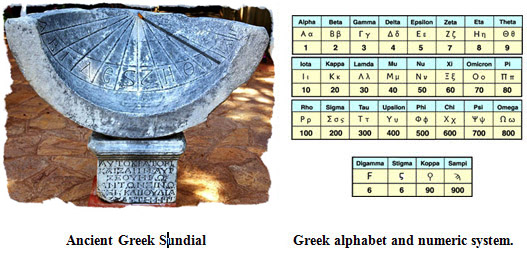 Sundials only measure direct rays of sunlight when the sun is ruling by day. Sundials can also measure the light of the full moon on the night that it rules. This is true for two reasons and in this order:
Sundials only measure direct rays of sunlight when the sun is ruling by day. Sundials can also measure the light of the full moon on the night that it rules. This is true for two reasons and in this order:
-
By its very design, a sundial implies and requires the ruling body to arise in the east and set in the west.
-
The ruling body must be of such significant brilliance as to emit rays that cast a shadow on the sundial. The sundial has no effect on the nights that the moon is in its dark occulted phase or has any portions of darkness. This is because all lunar phases that exhibit any portion of darkness also never rule the night sky from east to west beginning at sunset. It is only the full moon that accomplishes both, as it shines from east to west and emits enough light to project upon the sundial.
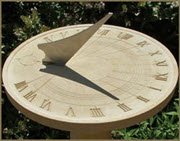 the day from the night.
the day from the night. In striking contrast, Roman Gregorian sundials follow a numeric system that displays the 12th hour as noon, correlating with a 24-hour day that commences at midnight. So, a sundial cannot truly measure a day that commences at midnight or at sunset, as with the Rabbinical Pharisee Jews.
Question 41: During the life of the Messiah, He kept the Sabbath for the correct length of time. If Israel was keeping it wrong, certainly He would have corrected them. How long did the Messiah declare a “day” to be, which would also apply to the seventh-day Sabbath day?
“Yahusha [Messiah] answered, ‘Are there not twelve hours in the day? If anyone walks in the day, he does not stumble, because he sees the LIGHT of this world.'” John 11:9 NKJV
“And as His custom was, He went into the synagogue on the Sabbath day [daylight], and stood up to read.” Luke 4:16 NKJV
Question 43: Yahusha, the Messiah, was the sacrificial Lamb who laid down His life as the sin offering on behalf of humanity. After an agonizing trial and beating, our Savior was placed on the cross/stake in the sixth hour. This begs the question, was this the sixth hour of the day or the sixth hour of the night?
“Now it was the preparation DAY [daylight] of the Passover, and about the sixth hour.” John 19:14 NKJV
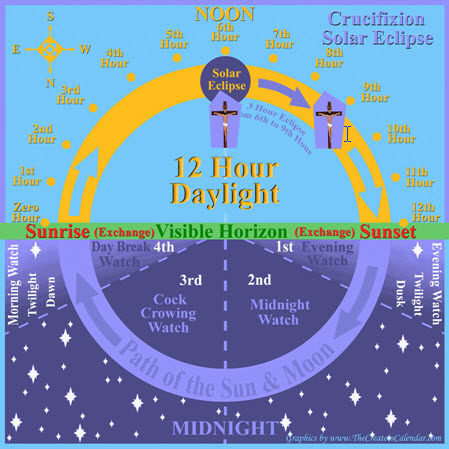
Question 44: According to Scripture, Passover, Abib 14, A.D. 31, appears to be the lunar calendar date of the crucifixion. This day of days, also known as the preparation day, contained only 12 hours from sunrise to sunset. How many hours did the following day contain?
- Now it was the Preparation Day of the Passover, and about the sixth hour. John 19:14 NKJV
- Now from the sixth hour until the ninth hour there was darkness over all the land. Matthew 27:45-46
- Now when the sixth hour had come, there was darkness over the whole land until the ninth hour. Mark 15:33-34
“From the rising of the sun to its going down Yahuah’s name is to be praised.” Psalms 113:3 NKJV
“The Mighty One, Alahim, has spoken and called the earth from the rising of the sun to its going down. Out of Zion, the perfection of beauty, Alahim will shine forth.” Psalms 50:1-2 NKJV
“For from the rising of the sun, even to its going down, My name shall be great among the Gentiles; in every place incense shall be offered to My name, and a pure offering; for My name shall be great among the nations,” says Yahuah of hosts.” Malachi 1:11 NKJV

From his book, “Book of Mysteries,” Jonathan Cahn relates wisdom from his teacher:“The earth is a sphere . . . and it turns on its axis on an east-west continuum. Therefore, the earth has a north pole and a south pole, but no east or west pole.”
“There is a measurable distance from the south pole to the north pole. Since there are two poles, the distance is limited. All north comes to an end at the North Pole. And all south ends at the South Pole. If the Temple had been built on a north-south continuum, then sin would have been removed a few thousand miles from the sinner, in a limited distance. But how far is the east from the west? East and west have no poles. Therefore, they never end. East and west are infinite. They go on forever. In fact, the Hebrew word for the EAST, kedem, also means everlasting.”
“But back then no one knew the earth was a SPHERE.”
“Alahim (God) did. And all this is a shadow of the atonement of Messiah, our salvation. So in Messiah, how far does Alahim (God) remove your sins from you? An infinity away . . . an eternity away. And if you had all eternity, you could never find them again. As it is written, ‘So far has He removed our sins away from us . . . AS FAR AS THE EAST IS FROM THE WEST.’”
The temple and its ceremonies performed on earth were to provide a word picture and prophetic storyline in types and shadows to illustrate the real work of salvation provided by our Messiah on the east-west time continuum. He alone was to be the Lamb sacrifice, the atoning High Kohen Priest, and the Eternal Father the Judge. Together, they have promised to the confessing sinners, who received forgiveness, “So far has He removed our sins away from us . . . AS FAR AS THE EAST IS FROM THE WEST.”
Historical Support Quotes
During the first and second Temple periods, the day was reckoned according to the astro-luni-solar calendar on an EAST-WEST perpetual time continuum. The Temple was opened during the daylight and closed during the night. The services began at sunrise, marked in the EAST by the sun, and were finished at sunset in the WEST when it set. Thus, the “day” of the Temple consisted of only half a civil calendar day, i.e., from sunrise to sunset and EAST to WEST. Yet Aaron was commanded in Leviticus 24:3-4 to order the seven lamps of the Menorah from sunset to sunrise, representing the period of night when the moon and stars rule by measuring time when the sun is not present at all.
“In the Hebrew mind the “DAY” began at the rising of the sun.” Vine’s Complete Expository Dictionary of Old and New Testament Words.“The sun alone indicated the hours for daily worship; at sunrise, when the day began, there was the morning sacrifice; at sunset, when the day closed, there was the evening sacrifice.”International Standard Bible Encyclopedia: “Astronomy” http://www.internationalstandardbible.com/A/astronomy-i.html [Search for Astronomy, and then select Astronomy 1. Scroll down to Section 5: Seasons and then scroll down further to the second part. The Quote above is the first sentence in the paragraph.]
“There only exists one time standard in the whole period covered by the Bible, i.e., the one taking the morning as the beginning of the day [daylight] . . .” U. Cassuto, in his Commentary on Genesis 1, (English edition in 1961).
“…the time of the transition from the reckoning of the day as beginning with morning to the reckoning of it as beginning with evening… that in the earlier calendar and in the literature which records this the day was reckoned from the morning, presumably from sunrise, while in the later calendar and the literature pertaining thereto the day was reckoned from the evening… Elsewhere we have presented quite a mass of evidence which establishes conclusively that the earlier practice in Israel during the Biblical period was to reckon the day from sunrise to sunrise… That in the earliest period of the Israelite sojourn in Palestine, under calendar 1, the day was reckoned from morning to morning is established by a superabundance of evidence… This in turn, together with other important considerations, would point to a time approximately about the beginning or the first half, of the third century B.C. as that of the introduction of the new system of reckoning the day.” Supplementary Studies in the Calendars of Ancient Israel, p. 1-148)
“In order to assure against profanation of the Sabbath the Jews added the late Friday afternoon hours to the Sabbath.” The Jewish Festivals: History and Observance, p. 13.
“If we look at the essentials of a day of rest and reflection, which has a religious orientation, it is possible to justify the shifting of the Sabbath worship to Friday evening [the celebration of which was moved back to the eve of the feast] as early as the Middle Ages . . .” Judaism: Between Yesterday and Tomorrow, Kung, p. 518.
“By cautioning the Colossian members not to let others judge them for how they observed the festivals, New Moon celebrations and Sabbaths, Paul didn’t question whether they should be kept. The obvious implication of these verses is that these Gentile Christians were in fact observing these days, and in no way did Paul tell them to desist. . . the festivals, New Moons, and Sabbaths, since the calendar governing those days was determined by movements of the heavenly bodies.” Sunset to Sunset: God’s Sabbath Rest,” p. 45.
During the Babylonian exile, the Rabbinical Orthodox Jews, known as the Pharisees, adopted the Babylonian sunset-to-sunset time measuring model as mentioned here. But it was not utilized by Israel until after the Roman occupation when the Rabbinical Orthodox Pharisees usurped their Oral Traditions and power over Israel. By the middle of the 4th century A.D., Hillel, head of the Sanhedrin, sanctioned the complete calendar change. This was done partly because of Roman pressure but also because they were motivated to separate themselves far from all ties to the TRUTH of the Torah Law and the part they had played in the death of the long-promised Messiah.
“It is not easy to draw any rigid lines separating [Orthodox] Jewish Law and Jewish custom [oral traditions]. There is an ancient saying that in Judaism, custom becomes Law. And the history of Judaism will reveal many religious laws widely recognized and observed, which had their origin in long-accepted folk practices… When the Jews returned to Palestine after their Babylonian exile (516 B.C.E.), they brought back with them the Babylonian astronomy and way of reckoning time…” What is a Jew, p. 105, 108.
“Later [Orthodox] Jewish calendar: Following the reign of King Josiah (c. 640-609) and especially after the Babylonian exile a number of significant and enduring changes occurred in the Israelite calendar showing that the [Orthodox Pharisee] Jews gradually adopted the Babylonian calendar of the time…The day however, was counted from evening to evening, after the Babylonian fashion. . .” New Catholic Encyclopedia, Volume 11, p. 1068.
“. . . ‘Remember the Sabbath day, to keep it holy’ by doing all one’s work in six days and by resting the seventh day ‘to the Lord your God.’ If we take a closer look at this text we will discover that the ‘time of Sabbath keeping’ is found within the Fourth Commandment. Since God called the LIGHT DAY, we are to remember the Sabbath LIGHT, to keep it Holy (Exodus 20:8). And that Sabbath is on the seventh LIGHT (Exodus 20:10), and not the seventh NIGHT. . . It is thus important to note at the outset that the method of observing the Sabbath from sunset to sunset is dictated not by the Fourth Commandment itself, but by the method of sunset reckoning, which became normative in [Rabbinical Pharisee] Jewish history.” The Time of the Crucifixion and the Resurrection, chapter 6.
[Later] “…The Israelites, like the Babylonians, counted their days from sunset to sunset…” NIV Study Bible, p. 707
Obviously the Jews in exile in Babylonia knew the calendars of the temples there; they knew the myths of the months. So effective was the influence of Babylonia upon them that they abandoned their own names for the months and accepted the Babylonian names.” Babylonian Menologies and the Semitic Calendars, p. 21.
“In addition to the decimal system familiar to Western culture (which uses powers of 10), Babylonian scholars also used a sexagesimal system (employing powers of 60) originally devised by the Sumerians and coming down to us in the form of the 60-minute hour and the 360-degree circle…This innovation directly inspired the calendar of Orthodox Judaism.” Peoples of the Old Testament World, p. 71.
“So far as we know, the Babylonian calendar was at all periods truly lunar… the month began with the evening when the NEW CRESCENT was for the first time again visible shortly after sunset. Consequently, the Babylonian day . . . begins in the evening…” The Exact Sciences in Antiquity, p. 106. [Note: All units of time were 180 degrees opposite of that of Scripture’s Torah.]
“The fact is that Rabbis of the Talmud no longer knew or would not acknowledge that in ancient times there was another mode of reckoning the day according to which the evening preceding the tenth day still belongs to the ninth day. In the case of the Day of Atonement the law especially prescribes that the fast be observed in a new manner, covering part of the ninth and part of the tenth day…” Rabbinic Essays, Page 447-451.
“In certain spheres of the population the older system continued to be in use, either exclusively or side by side with the newer system. Thus in the temple service the older system continued all through the time of the existence of the second temple, and there the day was reckoned from morning to morning…” Rabbinic Essays, Page 447-451.
“It may be surprising to some to note that no specific instructions are given in the Fourth Commandment on the manner and time of Sabbath-keeping. The only injunction given is to “Remember the Sabbath day, to keep it holy” by doing all one’s work in six days and by resting the seventh day “to the Lord your God.” If we take a closer look at this text we discover that the “time of Sabbath-keeping” is found within the Fourth Commandment. Since God called the light day, we are to remember the Sabbath LIGHT, to keep it Holy (Exodus 20:8). And that Sabbath is on the seventh LIGHT (Exodus 20:10), not the seventh NIGHT… It is thus important to note at the outset that the method of observing the Sabbath from sunset to sunset is dictated NOT by the Fourth Commandment itself, but by the method of sunset reckoning, which became normative in Orthodox [Pharisaical] Jewish history [as derived from Babylon].” The Time of the Crucifixion and the Resurrection, Chapter 6.
“In Israel, the day was for a long time reckoned from morning to morning… and it was in fact in the morning, with the creation of light, that the world began; the distinction of day and night, and time too, began on a morning (Gen. 1:3-5, cf. 14:16, 18). The opposite conclusion has been drawn from the refrain which punctuates the story of creation: “There was an evening and there was a morning, the first, second, etc., day;.” This phrase, however, coming after the description of each creative work (which clearly happens during the period of light), indicates rather the vacant time till the morning, the end of a day, and the beginning of the next work… The change of reckoning must therefore have taken place between the end of the monarchy and the age of Nehemiah… This would bring us to the beginning of the [Babylonian] exile…” Ancient Israel, p. 181-182
“In the Old Testament the earlier practice seems to have been to consider that the day began in the morning. In Genesis 19:34, for example, the “morrow (ASV) or “next day” (RSV) clearly begins with the morning after the preceding night…” The Handbook of Biblical Chronology, Jack Finegan, p. 7-8.
“The day was either the period of sunlight, contrasted with the night or the whole period of twenty four hours, although NOT defined as such in the Bible… In earlier traditions the day apparently began at sunrise (Lev. 7:15-17, Judges 19:4-19)… Later its beginning was at sunset and its end at the following sunset… this system became normative… and is still observed in Jewish [Babylonian Talmudic] tradition, where for example, the shabbat begins… at sunset and ends… at sunset. Oxford Companion to the Bible, p. 744.
“The flesh of the sacrifice of his peace offerings for thanksgiving shall be eaten on the day of his offering. He shall not leave any of it until the morning.” (Leviticus 7:15 This verse is discussed in the source below). (ibid)
“Obviously the implication here is that the next morning is no longer a part of the day upon which the sacrifice was offered, but marked the beginning of the next day… The day was at one time reckoned from sunrise to sunrise. The later practice was to reckon the day from sunset to sunset… It is impossible to tell exactly when this change in the mode of reckoning the day took place in Israel, and what causes brought it about… (ibid)
“It most likely coincided with the revision of the festival calendar, which took place in the period after the time of Ezra, and was, in all probability, the work of the soferim (scribes) or of the Great Synod (council) in the fourth century B.C. This may also be inferred from the statement in the [Babylonian] Talmud (Berachoth 33a) that the men of the Great Synod instituted the ceremonies of Kiddush and Havdalah, the solemn sanctification of the Shabbat… and its equally solemn ushering out… in other words, ceremonies specifically marking the beginning and the close of the Shabbat as at sunset. These were ceremonies for the Jewish home instead of the Temple. This coupled with the fact that in the second Temple the old system of reckoning the day from dawn to dawn [sunrise to sunrise] continued to be observed, as we have seen, may perhaps indicate that this entire innovation was the work of an anti-priestly group or party in the Great Synod…” The Sources of the Creation Story, Genesis 1:1- 2:4, p. 169-212.
“. . .the time of the transition from the reckoning of the day as beginning with morning to the reckoning of it as beginning with evening… that in the earlier calendar and in the literature which records this, the day was reckoned from the morning, presumably from sunrise, while in the later calendar and the literature pertaining thereto the day was reckoned from the evening… Elsewhere we have presented quite a mass of evidence which establishes conclusively that the earlier practice in Israel during the Biblical period was to reckon the [24 hour] day from sunrise to sunrise… That in the earliest period of Israelite sojourn in Palestine, under calendar 1, the day was reckoned from morning to morning is established by a super abundance of evidence… This in turn, together with other important considerations, would point to a time approximately about the beginning or the first half, of the third century B.C. as that of the introduction of the new system of reckoning the day.” Supplementary Studies in the Calendars of Ancient Israel, p. 1-148)
Summary of Q & A
- The first thing the Creator called into existence was LIGHT. Genesis 1:3.
- Darkness was not created by the Creator Yahuah, but rather, it is the absence of LIGHT and the absence of His creative power. Genesis 1:2-4.
- A DAY is the “sunlight” portion of a full calendar date, occupying the period from sunrise to sunset, and is defined by the hours on a sundial. Genesis 1:4, 5.
- A night occupies the portion from sunset to sunrise of a full lunar civil calendar date and is defined by four watches. Genesis 1:4-5.
- DAY and night are opposite periods of time that never overlap. Genesis 1:4, 5.
- A separating distinction was forever cast when the Creator named the LIGHT DAY and darkness of night. Genesis 1:4-5.
- Day and night are the two halves of a full lunar civil calendar date. Genesis 1:4, 5.
- The evening is equated with the mixture of light and darkness known as twilight, which occurs two times every civil day cycle: just before sunrise and just after sunset (Genesis 1:5).
- “The DAY commences at sunrise and ends at sunset and totals a period of twelve hours. John 11:9.
- All creation was accomplished during the LIGHT hours of the daylight, except when the light was called forth out of darkness on the first day. Genesis 1: all.
- The four watches of the night occupy the period between sunset and sunrise, as the length of night is defined by the visible stars. Jeremiah 31:35-36.
- The visible sun rules and measures the DAY, while the visible stars rule and measure the night. The day and the night can never overlap, any more than the shining of the sun and the stars can overlap or be visible at the same time. Jeremiah 31:35-36.
- The Creator declared six times in six days that His works of creation were accomplished during the daylight hours, then occurred in the evening (dusk twilight), and then occurred in the morning (dawn twilight). Genesis 1:1-31.
- The sun was appointed to rule over the day only and was never to have communion with or dominion over the night, according to Genesis 1:16.
- The moon, together with the stars, was appointed to rule over the night without interference from the sun (Genesis 1:16).
- Yahuah has always used the contrasting principles of LIGHT and DARK to teach His divine truths. “And what communion has the light with darkness?” 2 Corinthians 6:14; Proverbs 4:18-19; John 8:12; Matthew 5:14, 15; John 1:4, 7; John 3:20; 1 Peter 2:9; Ephesians 5:13.
- Metaphorically, darkness was to represent infidelity, spiritual blindness, and evil. Proverbs 4:18-19; John 1:4; John 3:20; 1 Peter 2:9.
- Metaphorically, LIGHT was to represent truth, divine understanding, and righteousness. Proverbs 4:18-19; John 1:4; John 3:20; 1 Peter 2:9.
- The terms next day or tomorrow refer to the daylight, which begins the next sunrise and ends at sunset. Exodus 18:13.
- Hypocrites call the night, DAY. This is represented by all those who believe the sanctified seventh-day Sabbath begins at sunset. Job 17:8-14.
- If the ordinance of the day and ordinance of the night were ever removed, then Israel was to cease being a nation. Every unit of time has been changed by both the Romans and the Yahudim (Jews). In addition to when the day begins, they have changed when the month and when the year begins. As a result, and based upon this verse in Job, Yashar’al (Israel) as a nation is no longer in a covenant relationship with Yahuah by their own choice and actions. Job 17:8-14.
- “The term “even unto even” refers to sunset unto sunset for the express boundaries of the fast of the Day of Atonement (Yom Kippur). Leviticus 23:5, 32.
- The Fourth Commandment supports what was discovered in Genesis 1:1-5: that the Sabbath is the DAYLIGHT portion of a fully lunar calendar date. The commandment makes absolutely no mention of the darkness of night.
- The Creator honored the Sabbath day and set it apart as sacred. Nowhere in Scripture is the dark of night ever set apart as sacred other than possibly the Feast of Passover, as only that night was divinely designed to symbolize spiritual blindness and evil. In the case of Passover, it was the blood of the Lamb, the Messiah, that was to rescue sinful mankind from the darkness of the world fallen into sin. Proverbs 4:18-19; John 1:4; John 3:20; 1 Peter 2:9.
- The Sabbath day is the same length of time as all other days, incorporating a period of 12 hours of daylight. Genesis 1:1-5; Genesis 2:1-3; John 11:9.
- “Yesternight identifies that “last night,” the night that ended at sunrise today, actually belongs to yesterday. But tonight, the night that comes after today, belongs to today’s calendar date. So it is impossible for a new DAY to commence at sunset, ever.
- During the Messiah’s life, it was His custom to enter the synagogue on the Sabbath day and never at night. (Luke 4:16).
- During the Messiah’s life, He declared that there are only twelve hours in a day. After all, He was also the Creator who called the LIGHT day and the darkness he called Night. He changes not. John 11:9; Ecclesiastes 3:14; Isaiah 40:8.
- In His death, our Messiah confirmed that the day is only twelve hours long. He was crucified in the third hour of daylight. The sun was darkened from the sixth to the ninth hour, which is a manifestation of the sun and a solar eclipse. At the ninth hour, He declared, “IT IS FINISHED!” and died. Remember, the night is not divided by hours; therefore, this is specifically referring to the daylight hours.
- There was a solar eclipse from the 6th to the 9th hour, highlighting that this occurred during the daylight hours and not at night. Lunar eclipses occur at night, but solar eclipses always occur during daylight.
- Yahuah declared that all nations of the earth would worship Him “FROM THE RISING OF THE SUN TO IT”S GOING DOWN.” Psalms 113:3; Psalms 50:1-2; Malachi 1:11.
- Salvation’s restoration of mankind in the temple type and shadow on earth was ordained to depict how far sin was to be removed from the confessing sinner. As far as the east is from the west.
- East means two things simultaneously: the point on the compass and the beginning of time.
- The Sun, Moon, and Stars were appointed to rule along the east-west perpetual time continuum, which declares that the day commences when the sun rises in the east.
Final Comments
The Creator’s original SIGNS OF THE TIMES can be identified from Scripture, History, and Astronomy. His SIGNS are born out of His trinity of LIGHTS, the sun, moon, and stars. His years begin in spring, instead of winter or fall, and are strategically set to begin on the first full New Moon of the spring. His months are lunar and commence upon the full New Moon, rather than the traditional crescent or newly interpreted dark conjunction lunar phases designated by the courts of Babylon or its Jewish adoptees of the fourth century. The Creator ordained the week to be counted from one to seven and cycle only four times each lunar month. Accordingly, the lunar weeks align in nearly perfect approximation to the four-quarter lunar phases following each full New Moon day. The day was to commence at sunrise and last for twelve hours, as measured by the shadow on the sundial. The day was then followed by the night, which is divided not by hours but by four-night watches.
Because the modern Roman calendar has divorced the moon from measuring months, weeks, days, and years, its units of time can NEVER be synchronized to the calendar of Scripture. In like manner, the modern Rabbinical Pharisee Jews have changed all their original units of time-measuring between the first and the fourth century A.D.. These changes to both the Roman and Jewish time systems cause all the calendar months, weeks, and days to float through that of our Creator’s STANDARD TIME-MEASURING MODEL. As a result, neither Friday, Saturday, nor Sunday can be consistently synonymous with our Creator’s true seventh-day Sabbath, ever.
We have read and reread the famous words from Revelation 13:3, “AND ALL THE WORLD WONDERED AFTER THE BEAST.” Yet, we have all been slow to discover how this reference to the BEAST would manifest. How does ALL the world wonder after the Beast? Is it a mere issue of keeping sacred the correct planetary day on the Roman calendar, such as Saturday vs. Sunday, as defined by Seventh-day Adventists? No, as that is impossible because Saturday and Sunday are twin sisters of the same fictitious time-replacement system. An illegitimate time measuring system proactively designed by the Romans to eliminate all things prophetically time-centric to the Torah Law. Then, later, the lie of the cycling week was adopted by the Jews to distance themselves far from the guilt and scrutiny that the lunar week and calendar would otherwise flaunt as self-evident, placing themselves as the chief conspirators in the death of their own Messiah.
Now that it is presented as an all-out calendar replacement assault against ALL time units manifest in Scripture’s TORAH (Law), each individual must make this a matter of prayer. We must trust that the same Eternal Father, Yahuah Alahim, and His Son, Yahusha HaMashiach (the Messiah), who together created the shamayim (heaven) and erets (the earth), have the power to lead you through, restoring you one truth after another in preparation for citizenship in His ETERNAL KINGDOM.
This website confidently expects and prays that these quotes from Scripture and History will stimulate your thoughts and actions and help you seek a deeper understanding of the truths of the Most High.
Who would have guessed that all our Creator’s units of time have been proactively hidden by the long-held traditions of church creeds, Rabbinical Pharisaical Yahudim (Jews), and their adopted Babylonian oral Talmudic traditions and set forth by the enemy of souls as the rule of thumb for sacred days?
May Yahuah continue to guide you as you seek to synchronize your soul temple to that of the FATHER OF LIGHTS (James 1:17) and salvation’s prophetic time-centric revelations.
For more studies on this subject:
A Day in Genesis – (Genesis 1:1-5)
Three Months in a Row – Part 2 – The Manna Feeding Schedule
Visible Stars Define the Parameters of Day and Night
Kerrie L. French
TheCreatorsCalendar29.5@gmail.com
TheCreatorsCalendar.com

